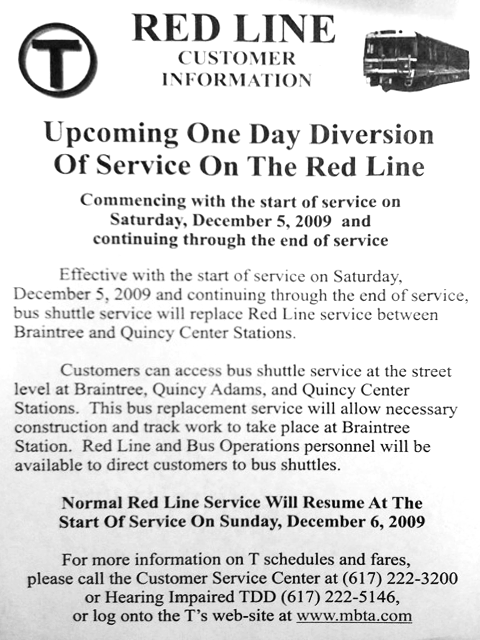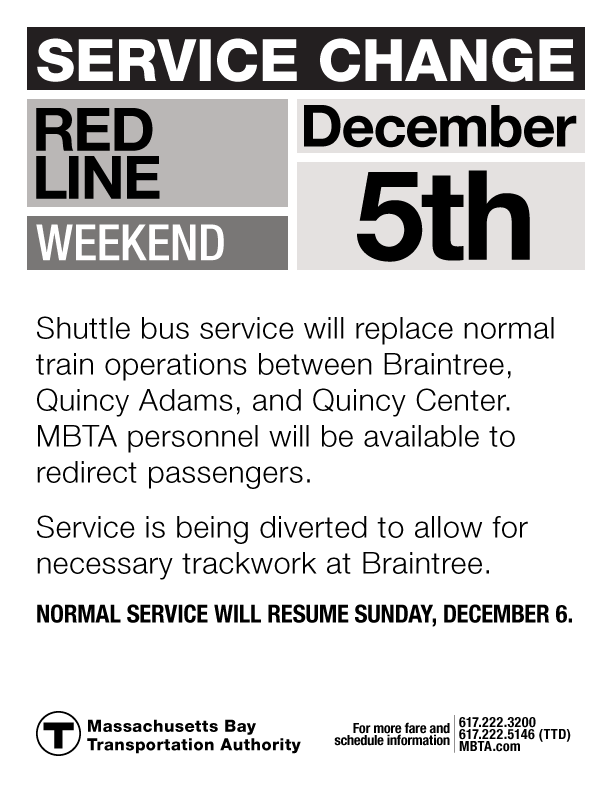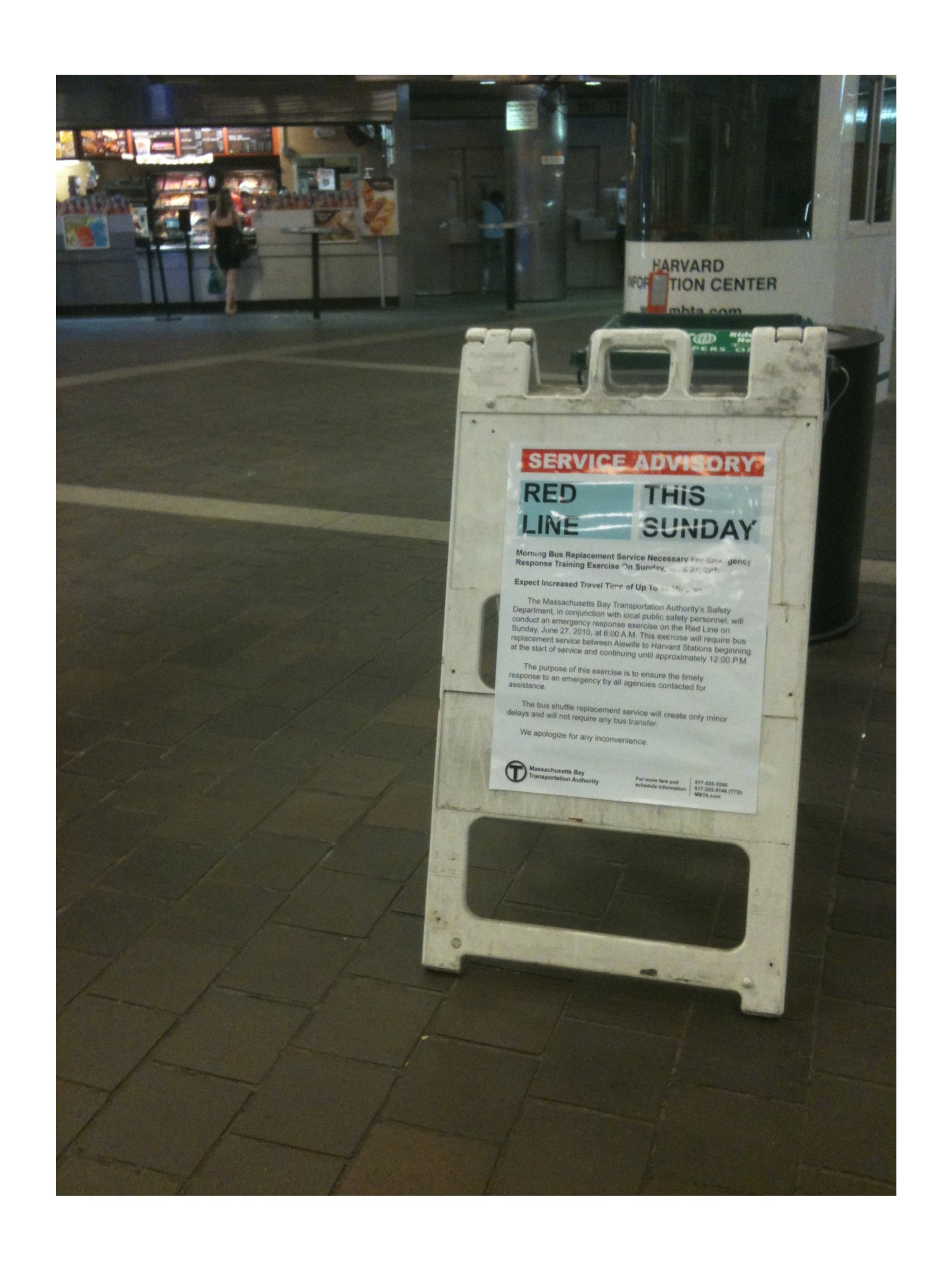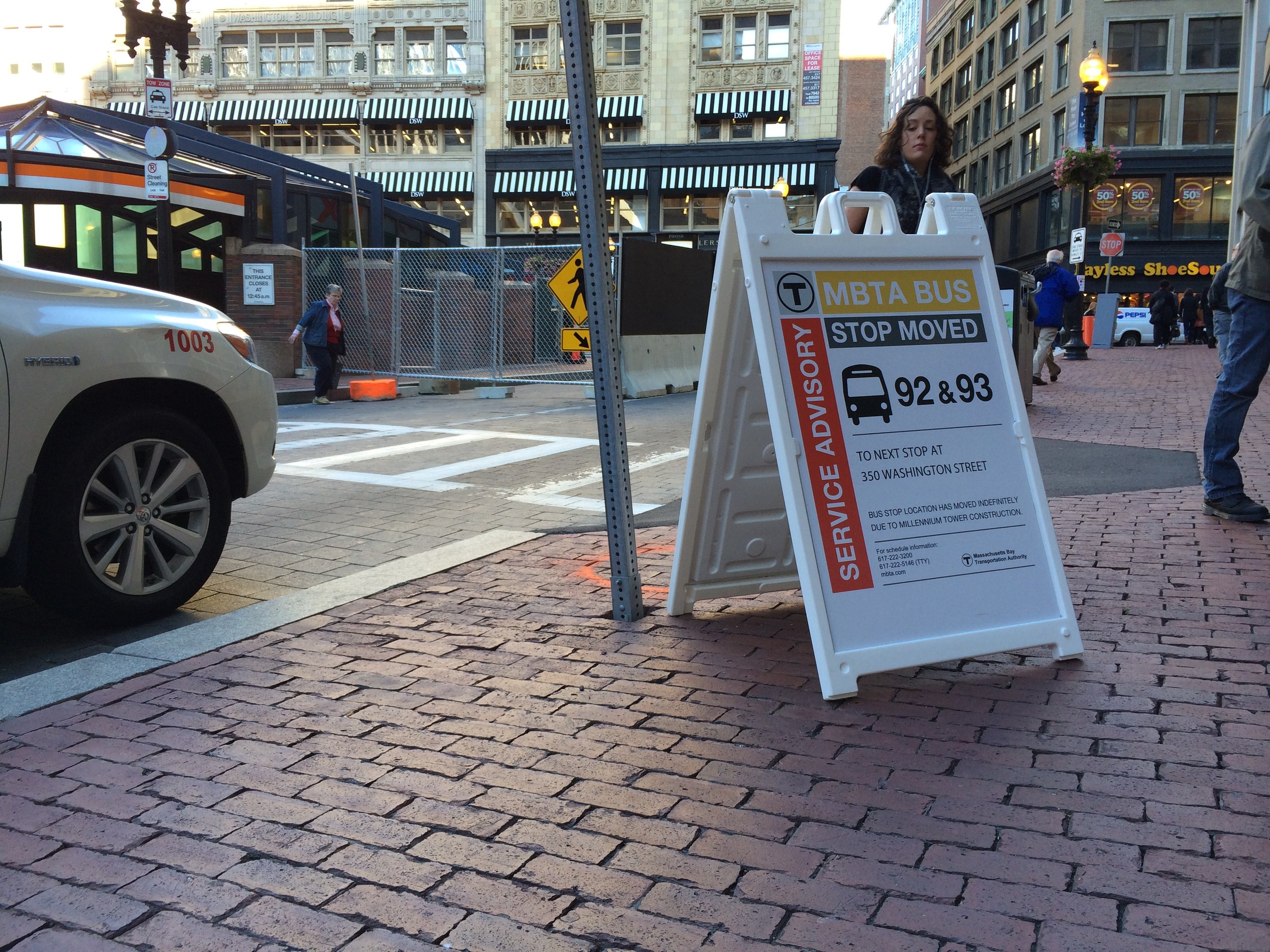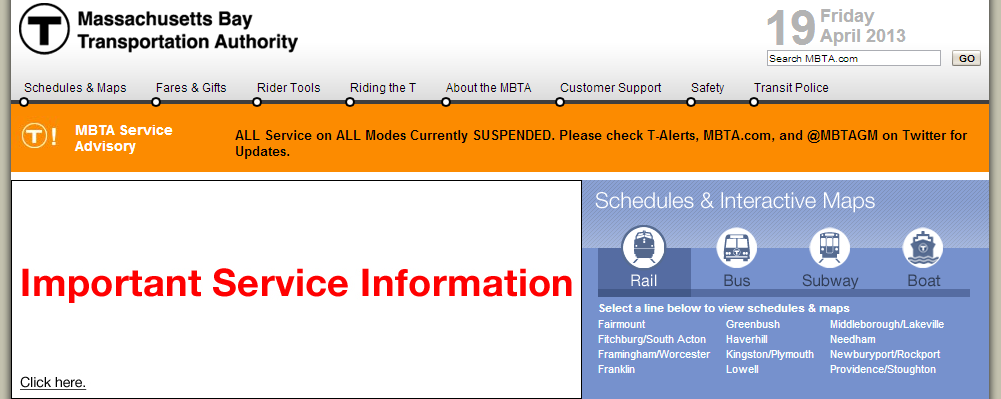
Celebrating 10 Years Of Advocacy: TransitMatters' Guerrilla Poster Campaign
For the next 6 weeks, we will be highlighting landmark moments in our organization’s history so far. First up: Our guerrilla diversion poster campaign, which inspired the T’s current diversion signage.
In December 2009, our founder, Marc Ebuña, came across a Red Line service advisory lying face-down on the floor. This advisory was from a "seat drop," which was one of the ways the T used to communicate with riders about service advisories. Seat drops were not effective. They often ended up on the floor, content side down. Seat drops could not communicate a message to an entire train car, let alone every rider.
The Red Line service advisory Marc found was poorly designed and written more like a press release than an alert. It had too much text, few visual cues highlighting the most important information, and poor branding, making it look unofficial.
We redesigned it, taking a page from the New York City Subway’s advisories at the time. We pulled key information into a high-contrast header, edited down the text significantly, and added the T’s official branding with contact information.
Our redesign posted above a service advisory from the T.
We offered the redesign to the MBTA and received a prompt response from the Deputy Director of Subway Operations. He referred us to the Red Line Chief of Operations, to follow up on design issues. We never got that follow-up.
In March of 2010, the Director of Innovation and Special Projects at MassDOT reached out via the MassDOT Developers Twitter account to invite us to a stakeholder roundtable with the incoming MBTA General Manager, Rich Davey. Here, we mentioned to the incoming General Manager our previous attempts to improve service advisories with staff. He encouraged us to post our designs the next time we saw diversion posters.
Early May 2010, we posted the redesigns. This seemed to push through the internal inertia required to get this prioritized. By mid-June 2010, the T was officially starting to pilot the new signs! Designs continued to evolve internally after then.
MassDOT Takes Pretty Pictures as Green Line Extension Gets Underway
 Work is finally underway for the much-awaited first phase of the Green Line extension north to Medford. Last December, MassDOT issued the first contracts to Barletta Heavy Division and followed that with the go-ahead to start construction on a set of demolitions and bridge widening projects that will, according to the MassDOT web site:
Work is finally underway for the much-awaited first phase of the Green Line extension north to Medford. Last December, MassDOT issued the first contracts to Barletta Heavy Division and followed that with the go-ahead to start construction on a set of demolitions and bridge widening projects that will, according to the MassDOT web site:
- Reconstruct and widen the Harvard Street Rail Bridge in Medford
- Widen the Medford Street Rail Bridge in Somerville
- Demolish 21 Water Street in Cambridge in preparation for the construction of the new Lechmere Station under Phase 2/2A of the GLX project
- Construct retaining walls and noise walls adjacent to the Harvard Street Rail Bridge
- Relocate MBTA Commuter Rail tracks in the Harvard Street Rail Bridge area
- Upgrade and replace existing storm drain system between Harvard Street and Granville Avenue
These projects will continue for 2 years until March of 2015. During that time, the state plans to maintain its transparency and documentation through photos. According to Joe Pesutauro of the MBTA:
With strong support from the Green Line extension team, DOT Communications staff has done a total of 53 separate posts with Green Line Extension meeting, outreach, and construction information since the MassDOT blog debuted 50 months ago. More than one [post] per month on average and more than on any other single MassDOT/MBTA project.
Each of those posts was accompanied with a Tweet and link on Twitter. Each such item is now also posted on our more recent MassDOT Facebook page, including two FB posts within the past week- one on the upcoming meeting and one displaying one of the Flickr construction photos. We have a Flickr set established to add future construction photos. All this in addition to the separate efforts on T social media.
The biggest highlight is MassDOT's latest album on Flickr, which captures the construction and is a great visual progress update. MassDOT has been doing this for some time to show very occasional and infrequent updates on bridge construction for the Accelerated Bridge Program, but the MTA has been posting album after album of construction updates for even less time. MassDOT started in the summer 0f 2009 with 1,165 uploads while the MTA has uploaded over four times that in half the time, starting with its first post in March of 2011.
Granted, the MTA has at least one dedicated photographer, but it has roughly the same number of ongoing capital projects and maintenance needs as MassDOT and the MBTA combined. Suffice it to say, MassDOT's planning site is well-organised, but much of the information is either hidden deep within many clicks or in lengthy PDF documents; the closest thing to a dashboard is the 'Projects' tab on the main MassDOT page. The MBTA's project page is slightly better, but is a simple table that doesn't give indication of scope or size of projects, instead listing project statuses. Deeper in, there isn't much consistency to project documentation, impact, or even format.
Other agencies have varying levels of success with building project dashboards. The CTA has a presentable planning site that highlights major upcoming projects. BART's project site is incredibly accessible through its good design via simplicity. SFMTA's site is more text-heavy, but highlights major projects well, perhaps only by default because they have fewer but wider-scoped projects. Washington Metro also has a very text-heavy project page littered with links to PDFs, but many of these are studies and preliminary analysis for projects and are well-organised into major categories on a single page. WMATA even has a rider-oriented blog-style site called PlanItMetro for focused feedback and updated on various projects, similar to MassDOT's blog. The NYC MTA, which has far more ground to cover than most in gaining public trust, has the best capital projects board; the capital projects are organised by division, similar to the way our capital projects are presented, and outlined with a breakdown of estimated and actual cost and deadline with notes for any discrepancy.
NYC's MTA arguably has bred a similar, if not deeper, strain of distrust as the MBTA and re-constituted MassDOT, which didn't exist until nearly four years ago. The MBTA/MassDOT need this kind of visibility and information accessibility. The T and MassDOT/former EOT have come a long way to show that they hold themselves accountable to its stakeholders outside of hour-long update meetings, regardless of whether the current people in leadership are responsible for the decades of actions that have bred the distrust in the agencies. A Flickr or Twitter feed or even Facebook page are more accessible than a physical meeting or even a PDF of the PowerPoint presentation from the meeting posted to the web.
The Green Line Extension does have a Facebook page, but as of this writing is not linked from the main project site, which suffers the same disjointed branding, presentation, and deep linking of information as many of MassDOTs other project pages. This capital project is the most promising in being a consistently transparent project through regular photo updates, but this consistency needs to be pushed across all projects and start well before any shovels hit the ground. This will be hard for the much maligned and beleaguered agencies, but both Secretary Davey and MBTA GM Scott deeply know and daily act on how important transparency is to public accountability and trust. While they're just getting started turning things around, many others in their field are leapfrogging past them and we can learn from those advances going forward.
Boston's Transit Network Shuts Down in Regional Manhunt - Confusion, Frustration Ensues
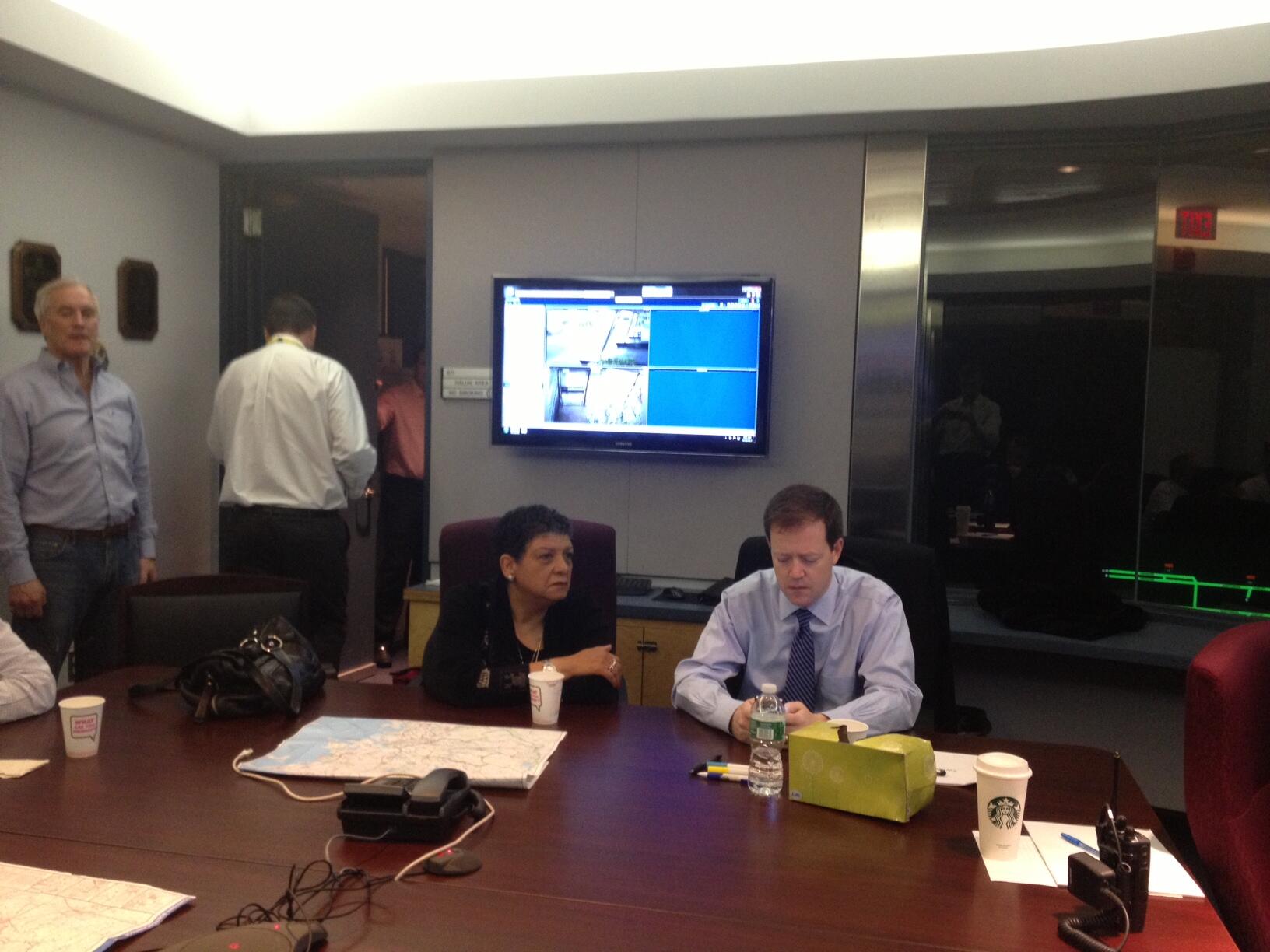 In coordination with local and state officials, all MBTA services were shut down early morning two Fridays ago, to facilitate efforts in the manhunt for the remaining suspect responsible for Monday's Boston Marathon bombings.
In coordination with local and state officials, all MBTA services were shut down early morning two Fridays ago, to facilitate efforts in the manhunt for the remaining suspect responsible for Monday's Boston Marathon bombings.
The ease of digital broadcasts helped the MBTA communicate the shutdown to its customers, but left those without a persistent digital connection in the dark. That morning, the Globe found riders were still confused and frustrated by the closure and lack of visible notice at stations:
Jonathan Cruz of Dorchester was on his way to his apprenticeship at Youth Build Boston, a program that teaches young people construction skills. An acquaintance stopped him on his way to the JFK/UMass Red Line station, warning him service was cancelled, but Cruz kept going, hoping to get more information at the station.
He arrived at the station at about 6:30 a.m. and found no signs about service [cancellation] and no employees, he said. His program has a very low tolerance for tardiness, and he was supposed to be in Roxbury by 7 a.m.
“I think they should have put signs up but the problem is, we have the Internet and we watch TV all the time, so they thought we would know,” he said.
This further highlights the need for non-digital information dissemination, accommodating those on the other side of the digital divide. Service notices need not be vinyl wall wraps that are planned weeks in advance, but the advancing deployment of advertising displays from Titan can certainly be instrumental in making it easier to inform those who otherwise arrive at stations:
Xheni Kurdari walked up the stairs at the JFK/UMass station and tried to open the station’s doors. No luck. She could not make the short commute to her job at State Street Bank and Trust Company in Quincy.
Kurdari said she went to bed early the previous night and did not hear the news of the police chase and shoot-out with the bombing suspects. She heard some sirens in the morning, but did not think much of them.
“I was wondering why there were no people around,” she said. “I’m gonna call my husband, I’m gonna wake him up, probably, and I’m gonna have him drive to work.”
Digital notifications are still one of the least effectively advertised customer information features in stations that can prove useful outside of it. I'm still surprised daily the number of passengers I encounter who don't realise that they can sign up for text-based 'T-Alerts' to their phones via SMS that don't require a smartphone. Even fewer people realise they can go to sites like NextBus.com for realtime bus arrival times and HowsTheT.com for realtime train arrival times from their PCs before they ever leave from home or work.
Of course, the MBTA website continues to be an indispensable resource, granted you can and know how to get there. Reaching out through the press in papers, television, and radio, can help circumvent the digital divide that still very much exists, even in Boston.
Signage in and around stations remains the most effective means of communicating with the public - that's why advertisers will pay to put signs in our stations...
Categories
- Children (1)
- Diversions (1)
- Olympics (1)
- MAPC (2)
- Red–Blue Connector (2)
- Urban Design (3)
- Bus (4)
- Fares (4)
- Late Night Service (4)
- MBTA ROC (4)
- Silver Line (4)
- Snow (5)
- Blue Line (8)
- Emergency (8)
- Orange Line (8)
- Public Comment (8)
- Maintenance (9)
- Operations (9)
- Signage (9)
- Fare Collection (10)
- Labs (11)
- Safety (11)
- Planning (12)
- Communication (14)
- MBCR (14)
- MassDOT (14)
- Green Line (16)
- History & Culture (16)
- Red Line (18)
- MBTA Bus (21)
- Commuter Rail (24)
- Advocacy (26)
- Capital Construction (28)
- Politics (30)
- Podcast (35)
- News (38)
- Media (40)
- Funding (42)
- Statements (50)
- MBTA (57)


